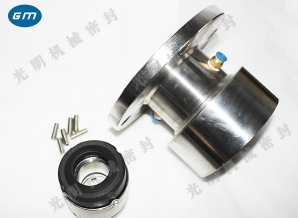For pump Mechanical seal manufacturer Common materials and selection principles
Mechanical seal selection method:
According to different working conditions and medium properties, mechanical seals include high-temperature and low-temperature resistant mechanical seals, high-pressure and corrosion resistant mechanical seals, particle resistant mechanical seals, and mechanical seals suitable for light hydrocarbon media that are easy to vaporize. Mechanical seals with different structures and materials shall be selected according to different uses.
The main parameters of model selection include: pressure of sealing chamber (MPa), fluid temperature (℃), working speed (m/s), fluid characteristics and effective space for installing seals.
Basic principles of model selection:
1. According to the pressure of the sealing chamber, determine whether the sealing structure is balanced or unbalanced, single end or double end
Noodles, etc.
2. According to the working speed, the rotary type or static type, hydrodynamic type or non-contact type shall be adopted.
3. Determine friction pairs and auxiliary sealing materials according to temperature and fluid properties, and correctly select lubrication
Washing, heat preservation, cooling and other mechanical seal circulation protection systems.
4. Multiple springs or single springs or Wave spring , built-in
Or externally mounted.
The mechanical seal is composed of static ring, dynamic ring, compensation buffer mechanism, auxiliary seal ring and transmission mechanism. The end faces of the static ring and the dynamic ring are perpendicular to the axis of the pump, and they fit together to form a rotating sealing surface. The stationary ring and gland, as well as the dynamic ring and shaft, are sealed with auxiliary seal rings to compensate the buffer mechanism action and drive the seal ring to move along the axial direction of the pump, keep the end faces of the dynamic ring and the stationary ring close together, and compensate for the wear of the end faces of the seal ring.

01 Main characteristic parameters of mechanical seal
1. Shaft diameter : The shaft diameter range of the pump mechanical seal is generally 6~200mm, and it can reach 400mm in special cases. The shaft diameter of the pump is usually determined according to the strength requirements, and it is rounded or adjusted with a shaft sleeve to meet the standard shaft diameter of the mechanical seal.
2. Speed : Generally, the speed is the same as that of the pump. Generally, the speed of the centrifugal pump is ≤ 3000r/min; High speed centrifugal pump ≤ 8000r/min; Special pump ≤ 4000r/min.
3. Average circumferential linear speed of sealing surface : refers to the circumferential linear velocity of the average diameter of the seal face. The average linear speed of the sealing surface has a great influence on the heating and wear of the sealing surface (i.e. friction pair). Circumferential linear speed of general mechanical seal ≤ 30m/s; Circumferential linear speed of spring static mechanical seal is ≤ 100m/s; In particular, it can reach ≤ 150m/s.
4. End face specific pressure : face specific pressure pc is the contact pressure (MPa) on the sealing surface. The end face specific pressure of the end face seal shall be controlled within a reasonable range. If it is too small, the sealing performance will be reduced, and if it is too large, the heating and wear of the sealing surface will be aggravated. Reasonable end face specific pressure value of pump mechanical seal; Internal mechanical seal, generally pc=0.3~0.6MPa; Externally mounted, pc=0.15~0.4MPa. When the lubricity is good, the end face specific pressure can be increased appropriately. For the liquid with high viscosity, the end face specific pressure should be increased, and pc=0.5~0.7MPa can be selected; For volatile liquid with poor lubricity, the lower end face specific pressure shall be taken, and pc=0.3~0.45MPa may be taken.
02 Assembly procedure of mechanical seal
The assembly method of mechanical seal varies with its structure. However, almost all mechanical seals need to be pre assembled and finally assembled.
1. Pre installation : It is to assemble parts into transmission components and static components. Install the movable ring seal ring into the inner hole of the movable ring to form the movable ring assembly. Install the spring and push ring on the spring seat successively, screw the drive screw into the push ring, adjust the pre compression amount of the spring, and form a compensation buffer mechanism. Align the pin and install the moving ring assembly into the compensation buffer mechanism to form the transmission assembly.
Install the stationary ring seal ring on the stationary ring and into the stationary ring seal chamber. Tighten the gland evenly to form a stationary component.
2. General assembly : Install the transmission component and static component into the shaft and seal chamber to complete the assembly of mechanical seal. Use a depth vernier caliper to measure the distance from the end face of the dynamic ring seal to the end face of the seal chamber and the distance from the end face of the static ring seal to the end face of the end cover. The actual compression amount of the mechanical seal is the specific pressure, which can be properly adjusted in actual work.
Excessive compression of mechanical seal spring will affect the service life of mechanical seal, otherwise, mechanical seal is easy to leak.






